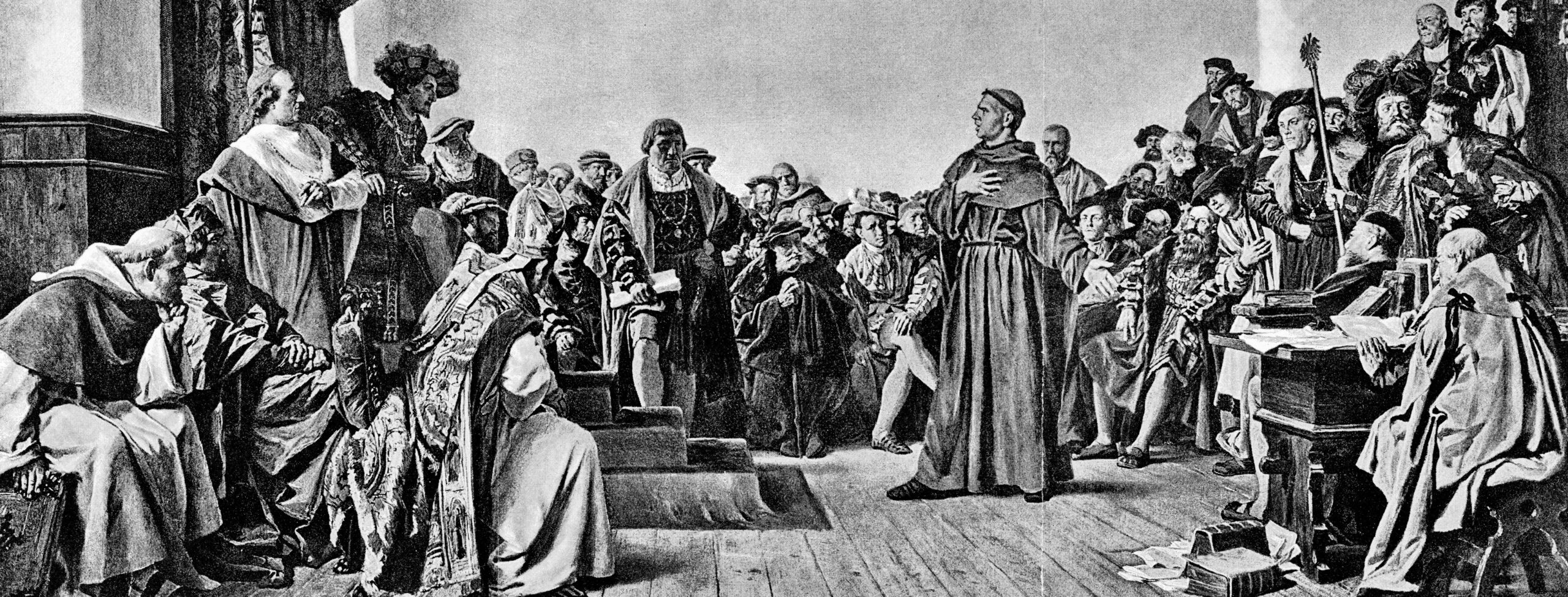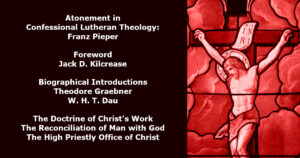by T. R. Halvorson
Note: This article may be downloaded as a PDF file.
Outline
- Citation
- Evaluation
- The Atonement in Lutheran Theology
- Plan of the Book
- The Problem
- Teaching of Christ and the Apostles
- Teaching of the Postapostolic Fathers
Citation
Dierks, Theodore. Reconciliation and Justification. St Louis: Concordia Publishing House, 1938.
Evaluation
Dierks’ work in Part I, pp. 15-64, on the teaching of Christ and the Apostles about atonement, justification, and reconciliation could free-stand as a valuable monograph on its own. These pages viewed as a unit apart from the rest of the book rank in the top handful of Lutheran writings in English on the atonement. Every Christian – lay people, pastors, theologians, professors, teachers, all – would benefit richly from reading and rereading this part.
In such writings from the subapostolic era that we have, the corruption of the Gospel in so many early Church fathers is severely disappointing. Many Christians would be unsuspecting when reading those writings and could be led astray. Dierks’ work in Part II is highly valuable because it provides a vital, fair, and accurate analysis of those writing showing how the Gospel was corrupted in many of them, but also how it was conveyed purely by some. Having his survey can help protect a person from being led into the corruptions.
The Atonement in Lutheran Theology
Lutherans repeatedly say that justification is the article of faith upon which the church stands or falls. This is most certainly true. But the atonement goes along with that. In his article, “Flights from the Atonement,”[1] Dr. David P. Scaer
addresses the tendency of Lutherans to see atonement as a doctrine easily separated from – and less important than – justification. He demonstrates the intimate interrelationship and interdependence of these doctrines.[2]
In line with Scaer’s perspective, this work by Theodore Dierks, though titled Reconciliation and Justification, also is a book about the atonement. Dierks is keeping all three together the way Scaer says they should be.
Plan of the Book
The book has four major divisions:
- The Problem. A statement of the problem under study in the book
- Part I. Reconciliation and justification as taught by Christ and the Apostles
- Part II. Reconciliation and justification as confessed in the Church in the first century after the Apostles
- Conclusion
The Problem
There is a common contention that the church did not start with the fullness of apostolic teaching. Under this view, the church had only a vague, indefinite, and imperfect conception of justification, reconciliation, and atonement. The truth had to be developed gradually through the centuries.
Under that contention, many claim the postapostolic fathers had their own Christianity essentially independent of the apostolic literature.
This contention denies that Scripture is the only inerrant source and criterion of Christian truth.[3]
Against that contention, Dierks maintains that the doctrine of justification by faith has been confessed by Christians throughout all ages. This truth was confessed and believed already in the Old Testament. Dierks observes the teaching of Christ and the apostles and then compares the teachings of the postapostolic fathers to it.
Teaching of Christ and the Apostles
The orientation of sin and its consequences affects the orientation of atonement and its benefits.
While sinners suffer physical and spiritual death, bondage to sin, bondage to the devil, lostness, blindness, darkness, inherited corruption, and inability to deliver themselves from these conditions, Dierks says Christ and the Apostles orient these as the consequence of legal guilt. These are judgments and punishments of God for the guilt of sin. Bondage to the devil is not of the devil’s own power or right, but by God using the devil as an executioner of judgment.[4]
Why is man unable to free himself from the bondage of sin? It is because he cannot remove his guilt. As long as he is guilty, he is under the bondage of sin because of the judgment of God; and as long he is under bondage, he can only heap guilt upon guilt.[5]
“The devil is merely God’s executioner, carrying out the judgments of God.”[6] “If God no longer pronounces condemnation on the sinner, the devil can no longer rule over such a one.”[7] “Since the guilt of sin has been made of none effect, man has also been redeemed from eternal death.”[8] “Since the guilt of sin has been cancelled, man is also delivered from the power of the devil.”[9] “Because the guilt of sin has been erased, therefore we are no longer under the judgment of God to suffer the penalty of guilt, i.e., to be under the bondage of sin, death, and the devil.”[10] “In all this, the blotting out of the guilt of sin by the self-sacrifice of Christ must always be emphasized as the cause and source of redemption from sin, death, and the power of the devil.”[11]
In order to efface the guilt of sin, God sent His only-begotten Son into the world to take the place of sinful man. Of Him God demanded perfect obedience to His holy Law, and imputing to Him the guilt of all sins of all men, He demanded that He pay the penalty. Through His vicarious satisfaction, or atonement, Christ turned the wrath of God into grace and favor. In other words, in Christ, God reconciled the world unto Himself, not imputing their trespasses unto them (objective justification); and whoever believes and accepts this reconciliation has forgiveness and pardon (subjective justification).[12]
Understanding objective justification and subjective justification has may implications for what the Gospel is, what the Church is to proclaim, what the ministry of the Church is, etc.[13] “If we make a mistake here, we cannot rectify it afterwards.”[14] “When God in Christ established the new covenant and forgave man all his sins, He made this fact known through the Gospel.”[15] “It is only in the Gospel and the Sacraments that forgiveness is offered and conveyed.”[16] “This objective reconciliation, or justification, is that new covenant which Christ proclaimed when He instituted the Sacrament of His body and blood.”[17] “The Gospel is the proclamation of the objective reconciliation and justification; and whoever believes this ‘Word of Reconciliation’ is thereby subjectively justified.”[18]
Dierks quickly examines many statements in Scripture that show Christ and the Apostles teaching Christ as substitute for sinners. Christ had no sin of his own, but the sins of all men were imputed to him, then He suffered the punishment for everything imputed to him and his righteousness was imputed to us.
In the course of explaining these truths, Dierks refutes faulty ideas of the atonement, such as that the incarnation itself accomplished the reconciliation of God and man before and without the cross; that the substitution of Christ for sinners was representative rather than penal; that the atonement that the Church teaches originated with Paul and was not taught by Christ or the other Apostles; or ideas that reverse the orientation of atonement so that deliverance from sin, death, and the devil is independent from propitiating the guilt of sin and turning away the wrath of God.
Emphatically, Dierks says, “The Gospel of Jesus and the Gospel of Paul are one and the same thing.”[19] “The thoughts which Paul has in common with Jesus are: Christ gave His life into death as the price paid in order to propitiate and thus deliver the many from bondage.”[20]
In the Levitical sacrifices, the priest sprinkled the blood of the sacrifice on the mercy seat. The mercy seat was the cover of the Ark of the Covenant. Within the Ark was the testimony, that is, the tables of the Law, which testified against us of our sin, guilt, and curse. With our sin in God’s sight, He had wrath toward us, but with our sin covered and hidden from his sight by the blood and mercy seat, God is propitiated, we are forgiven, and God is favorable to us. Christ and the Apostles preach Christ as all three – priest, sacrifice and blood, and mercy seat – working the propitiation of God for us.[21]
Dierks distinguishes justification before God and justification before man. The difference makes sense of otherwise seemingly contradictory statements in Scripture. It helps us avoid falling into erroneous doctrines that reintroduce works into justification before God on the one hand or turn the Gospel into license to sin on the other.
Dierks explains the proper distinction between Law and Gospel and in this connection the proper roles of contrition and faith in repentance. Contrition is necessary, but not because it merits anything or because it is a necessary condition for the forgiveness of sins, but because it prepares the sinner for faith. “They that be whole need not a physician but they that are sick.” Luke 5:31. In the early church, most of those whose writings we have did not properly distinguish Law and Gospel.
Teaching of the Postapostolic Fathers
Dierks portrays the teaching of the postapostolic fathers by examining the existing writings of Clement of Rome, Ignatius (Bishop of Antioch), Polycarp (Bishop of Smyrna), the Epistle of Barnabas, the Didache, the Shepherd of Hermas, the Second Epistle of Clement, Justin (the philosopher and martyr), Iranaeus (Bishop of Lyons), and the Epistle to Diognetus.
We must approach this body of literature with a general significant caveat. These writings are not intended as dissertations on doctrine. Mostly they are exhortations to holy living. During these exhortations, the writers make some isolated statements about reconciliation. The view of the subapostolic period derived from a study of these documents does not necessarily represent what the pastors, elders, and bishops were teaching doctrinally in the church. We look at this evidence because it is evidence we have, but it always should be read together with the New Testament including the epistles of Paul because these were circulating and being read in the churches.
Dierks maintains that the apostolic doctrine of reconciliation and justification in its broadest outline was expressly and definitely taught and confessed in the subapostolic writings. They taught that God was reconciled to man through the death of Christ and that we receive forgiveness of sins through faith in Christ.
But nearly all these writers did not hold fast to the scriptural doctrine of the objective reconciliation and justification. They did not rightly distinguish between Law and Gospel. This led to a corruption of the scriptural doctrine of subjective justification.
Generally, the postapostolic literature laid all the emphasis on the dominion of sin. The focus was on man being under bondage to sin, death, and the devil. This practically ignored the guilt of sin. This constituted a corruption of the truth.[22] As a result, there is a “morass of unscriptural and soul-destroying doctrines found in some of the subapostolic Church Fathers.”[23]
Most of these Church Fathers did not hold fast to the objective reconciliation and justification as an accomplished fact, and therefore the Scriptural doctrine of subjective justification, i.e., justification by faith alone, gradually became justification by faith and works and then justification mainly by works, faith being regarded only as assent to the Rule of Faith. … [T]hey could not and did not rightly distinguish between Law and Gospel, and thus they corrupted the truth of Scripture.[24]
“This corruption is not found in the Epistle to Diognetus.”[25] “We find the truth of Scripture here confessed in all its pristine glory.”[26] “Here in this epistle we find the Scriptural doctrine of reconciliation and justification confessed and restored to its original purity.”[27] Also, in the doctrine of justification, Clement, Ignatius, and Polycarp walk very close to Scripture.[28]
[1] David P. Scaer, “Flights from Atonement,” Concordia Theological Quarterly, vol. 72, no. 3, 2008, pp. 195-210.
[2] “Charles A. Gieschen, “The Death of Jesus as Atonement for Sin,” editorial introduction to Concordia Theological Quarterly, vol. 72, no. 3, 2008.
[3] “The idea of doctrinal development, i.e., that the Christian truths have been, and must continue to be, developed through the ages, received new impetus through the labors of Schleiermacher, and it controls all modern theology. Here we may distinguish two schools of thought. The one school maintains that the Bible is only the first series in the development of the truth and that only the germ, or embryo, of the truth is contained in the Scriptures. Through the centuries the theologians have gradually evolved and expanded this germ of truth to that theology which we have today. The duty to the theologian is to continue this development. But this thought is to be rejected; for thereby it is plainly denied that the Bible per se is the only infallible and inerrant authority, source, norm and rule of Christian truth.” Dierks, 6.
[4] This orientation accords with Luther’s teaching in the Large Catechism. See Albrecht Peters, trans. Thomas H. Trapp, Commentary on Luther’s Catechisms, Creed2 (Concordia Publishing House, St. Louis: 2011), 161-162.
[5] Dierks, 19.
[6] Dierks, 43.
[7] Dierks, 43.
[8] Dierks, 43.
[9] Dierks, 43.
[10] Dierks, 44.
[11] Dierks, 43.
[12] Dierks, 21.
[13] Dierks, 36-41.
[14] Dierks, 38.
[15] Dierks, 44.
[16] Dierks, 45.
[17] Dierks 39.
[18] Dierks, 46.
[19] Dierks, 30, emphasis in the original.
[20] Dierks 31.
[21] Dierks, 35-36.
[22] Dierks, 4.
[23] Dierks, 160.
[24] Dierks, 161-162.
[25] Dierks, 13.
[26] Dierks, 160.
[27] Dierks, 161.
[28] Dierks, 13.




